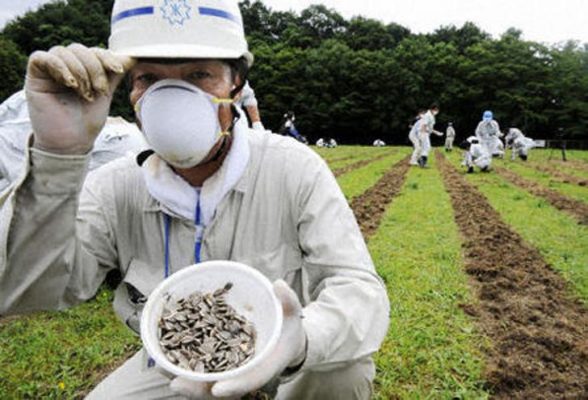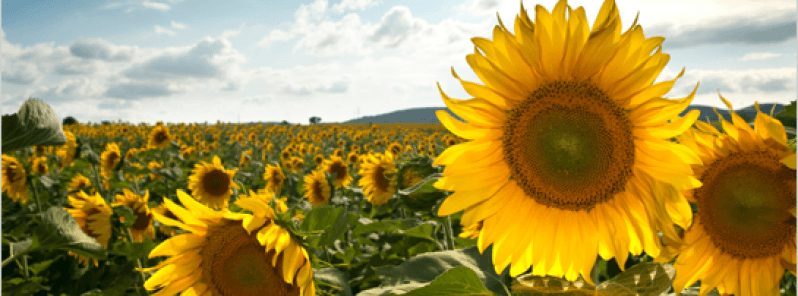In this very informative post from preparedness writer James Ryan, we find out how the humble sunflower removes radiation from contaminated soil, and how it is helping communities to clean up contamination hot spots in Fukushima and Chernobyl.
The sh-t has finally hit the fan. A North Korean nuclear bomb has been detonated in Japan and a nuclear cloud has been blown across the Pacific and is lingering above your city. After two days, you climb out of your bunker. You’ve got your gas mask and protective equipment on and your radioactivity detector in your hand. The radioactivity levels are unsafe, but you manage to detect cesium-134 – an isotope with a two-year half-life. But you are already halfway through a 72-hour ration pack. You could scavenge for a while, but you need to purify the soil so you can start to grow your own food and your country can consolidate and rebuild.
Preppers who are looking for a solution for the cleaning of radioactive soil need to look no further than the symbol for nuclear disarmament, the sunflower. Sunflowers are a particularly robust crop which can be successfully grown in both temperate and tropical regions. This covers most growing zones in North America, South America, and Europe.
Their seeds have many uses. They are highly nutritious and are often used as food crops for humans, cattle, and poultry. Furthermore, Native Americans often used the seeds to treat rattlesnake bites. However, they are of particular use in the case of a nuclear fallout.
What is the current approach to removing radiation from soil?
Currently, many companies tasked with removing nuclear waste from spoil rely heavily on excavation. The issue with excavation is that soil is quite bulky, therefore, the process is financially and environmentally costly.
Furthermore, it would be impractical for preppers to excavate soil in the case of nuclear contamination, whether it be due to a nuclear storage leak, bomb, or malfunctioning reactor.
While nuclear-contaminated soil might place a large dent in your survival plans, scientists have found that sunflowers may be the everyman solution.
How can sunflowers help?
Sunflowers are hyperaccumulators. This means that they are able to absorb high concentrations of toxic materials, including zinc, copper, lead and radioactive waste from soil and water.
The resulting waste is stored in the leaves and stems of the sunflower. As the human gastrointestinal tract can be measured at around 25 feet (7.6 meters), the complex anatomy of sunflowers allows the storage of huge amounts of toxic materials.
This process, called bioremediation, is quite simple. Explosion induced radiation (from bombs and reactors) is often airborne. When it reaches the ground, it often rests on the top layer of soil.
If sunflowers are planted after a nuclear disaster, some of the nuclear waste will be absorbed and converted into a carbon-based substance in the plant material. When they have absorbed the majority of the waste (normally after three weeks), they are incinerated and the ash is stored in the same manner as other nuclear waste.
Choosing the right sunflowers

There are two main types of sunflowers, perennial and domesticated sunflowers. Perennial sunflowers are often considered pests, because they are able to spread quite rapidly. In the event of nuclear fallout, this ability to self-reproduce could be quite useful.
Furthermore, they are in areas that are particularly vulnerable to pollution – moist soils and waterways. Therefore, they are likely to self-spread and reduce the levels of radioactivity around your family home or demarcated RV.
Sunflower seeds are not the only hyperaccumulators capable of cleaning up nuclear waste. Sunflowers, field mustard, amaranthus, and cockscomb are being used to clean up Fukushima and Chernobyl. So it is important for you to understand what seed grows best in your area and make that part of your prepping strategy.
The only weakness is that this process reduces the radioactivity in the top layer of soil. Therefore, it fails to deal with other factors which could allow the soil to permeate deeper layers of soil or waterways, such as rain.
Nevertheless, it could make a significant difference in the ability of preppers to react to a nuclear contamination.
Where do I get the seeds?
Sunflower seeds can be found in a range of gardening shops, both online or in your local area. Otherwise, you can harvest them from a friend’s garden.
You need to be sure that you buy perennial sunflower seeds, as they are the most suitable for a nuclear situation. If you like the look of sunflowers, just plant the domesticated version as the perennials are likely to take over your whole garden. Otherwise, plant the perennials in pots. The seeds are easy to harvest and store.



I was wondering how remove radiation. that is one area I am not prepared for.
Then what do you do with the radioactive plants ?
It said burn them and store the remains (ashes) as you would any irradiated material. Better have some drums too.
Great 2 for 1 .cleans my soil then I can feed the seeds to the bad guys
Are Sunflower seeds used for toxic radiation extraction, harmful to seed eating birds?
yes we may not eat these contaminated flowers but will the birds and the bees. Great concern. I am researching. I think that I might try them in my garden where there is fungus, see if it cleans the soil Guess for the toxic ones would have to cover with nets?
I doubt there will be much wildlife to worry about after a nuclear disaster.